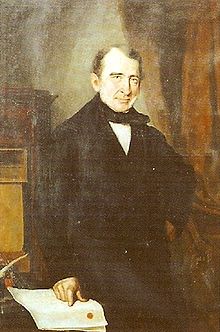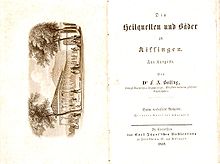Franz Anton von Balling
Franz Anton Balling , 1874 by Balling , (* 7. February 1800 in Sulzfeld (in the grave field) ; † 22. April 1875 in Kissingen ) was a German Balneologe , spa doctor and entrepreneur .
Life
Balling was the son of a teacher. He spent his childhood in Neustadt an der Saale and from 1814 attended the Gymnasium in Münnerstadt , always as the best in his class. From 1819 he studied medicine at the University of Würzburg , although he also had a tendency towards theology and philology . In 1824 he completed his studies with a doctorate .
From 1826 he was an assistant doctor at the Juliusspital Würzburg . He received a scholarship to continue his studies at the universities in Berlin , Vienna and at the Sorbonne in Paris . For a short time from 1832 Balling was professor of surgery and director of the clinic in the surgical school in Landshut , but was dismissed because of his liberal views. In 1833 he was a spa doctor in "Ludwigsbad" in Wipfeld (Lower Franconia), but in 1834 he was the first official spa doctor to settle in Kissingen and built his own spa, the Ballinghaus , which still exists .
Later he was one of the main initiators of the founding of the Actienbad (later: Luitpoldbad ), the largest bathhouse in Europe at the time, and founded the Polytechnic Association, a training facility whose teachers he paid out of his own pocket. Due to his great interest in agriculture and horticulture , he designed his piece of land on Finsterberg, which had grown piece by piece, into a model agricultural complex (from 1890: Ballinghain ). There he planted and raised fruit trees with his own hands and he passed the knowledge he gained on to the neighboring farmers. His wish to keep this garden after his death was not granted. In 1899 the heirs decided to sell an area of 24.5 hectares to the city for 18,000 marks. The city administration made the Ballinghain out of this complex, and the Kissingen honorary citizens Ernst Hübner , Franz Siechen - the stone Siechenbank and the Hübnerbank are still reminiscent of them today - and Adolf Güterback also took care of it. The former opera singer Pauline Horson-Brügelmann donated 150,000 marks. On Balling's 100th birthday, his bust was erected on Ballinghain in 1900.
As early as 1837, Balling gave his spa guests a good recommendation to travel to Kissingen in his first pamphlet, which was only raised to the spa in 1883 by the Bavarian “fairy tale king” Ludwig II : “The journey is as comfortable, slow and calm as possible when the weather is favorable with suitable resting points while avoiding all excesses in eating and drinking. "
In 1855 he was appointed royal Bavarian councilor , in 1865 he was made an honorary citizen of Bad Kissingen and in 1874 he was raised to the personal nobility when he was awarded the Order of Merit of the Bavarian Crown in 1874 . He was a member of the magistrate .
Balling, a member of “various learned societies” and private lecturer in Würzburg, was active as an author and translator from French, especially in the field of balneology , in addition to his medical work .
He corresponded in 1844/51 a. a. also with the physician Rudolph von Vivenot .
Balling married the Kissingen merchant daughter Anna Maria Schoeller in 1836 (* June 27, 1813; † November 18, 1886). Both graves are preserved in the chapel cemetery in Bad Kissingen.
Works (selection)
- The healing springs and baths in Kissingen . A paperback for spa guests and doctors, Jügel Verlag, Frankfurt (Main) and Kissingen 1838 - 9 editions, the last only after his death. The French edition was probably written by him, too, since he was also a translator.
- Kissingen. Des Eaux minerales et ses Bains (French). Frankfurt am Main 1839
- Brief news about the mineral springs, carbonic acid gas, hydrochloric acid steam and mud baths, as well as about the whey institute in Kissingen , Jügel Verlag, Frankfurt am Main 1841
- Letters about the effects of the mineral springs in Kissingen , Osterrieth Verlag, Frankfurt am Main 1859
Awards
- Order of Merit of St. Michael I Class
- Order of the Württemberg Crown
- Order of the Crown III. class
- Swedish Wasa Order
literature
- Gerhard Wulz: The chapel cemetery in Bad Kissingen. A guide with short biographies. City of Bad Kissingen (Ed.) 2001, ISBN 3-934912-04-4 .
- Gerhard Wulz: The Ballinghain in Bad Kissingen. In: Saale newspaper. from July 15, 2000 and in Franconia. 1999, p. 368.
- Peter Weidisch (ed.): The early days of the bath Kissingen. P. 33, in: Bad Kissinger Museum Information. Issue 2, Verlag Stadt Bad Kissingen, Bad Kissingen 2008, ISBN 3-934912-10-9 .
Web links
Individual evidence
- ↑ Some sources name the year of birth 1802 , but the tomb indicates the year 1800 .
- ↑ Thomas Mäusers: The almost forgotten plant. in: Saale newspaper . from August 15, 2011.
| personal data | |
|---|---|
| SURNAME | Balling, Franz Anton von |
| ALTERNATIVE NAMES | Balling, Franz Anton |
| BRIEF DESCRIPTION | German balneologist, spa doctor and entrepreneur |
| DATE OF BIRTH | February 7, 1800 |
| PLACE OF BIRTH | Sulzfeld (in the grave field) |
| DATE OF DEATH | April 22, 1875 |
| Place of death | Kissingen |



